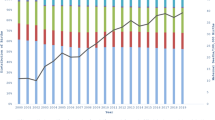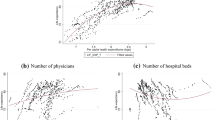Abstract
Using data about births from the perinatal information system (PIS) registered in Montevideo (Uruguay), we estimated the probability of having a Caesarian section delivery, controlled by risk factors and the endogeneity of the choice of hospital. In public hospitals in Montevideo there is a fixed payment system, but in private hospitals this procedure has to be paid for separately. In the former, there is no effect on the doctor’s income if he performs a Caesarian, but in the latter there is a positive effect. Empirical evidence shows the probability of a Caesarean section increases with the age of the woman, the presence of eclampsy, pre-eclampsy, previous hypertension, previous Caesarean sections, multiple pregnancies and fetopelvic disproportion, and decreases for multiparous women and women in a public hospital. In fact, the probability of having a Caesarean section in a private institution is almost two times higher than in a public hospital (20% as against 39%). Focusing on women without risk factors, we found that the probability a Caesarian in a public hospital was 11%, but the probability in a private hospital was 25%. We conclude that the remuneration system explains an important part of this difference.
Similar content being viewed by others
References
Baum, C. F., Schaffer, M. E., & Stillman, S. (2003). Instrumental variables and GMM: Estimation and testing, Boston College, Working Paper 545.
Bucheli, M. (2000). Remuneraciones del sector salud, Informe para el Banco Interamericano de Desarrollo, Unidad Preparatoria del Proyecto UR120 (Reestructuración del Hospital de Clínicas de la Universidad de la República), unpublished.
Buglioli M., Gianneo O., Mieres G. (2002) Modalidades de pago de la atención médica. Revista Médica del Uruguay 18(3): 198–210
Centro Latinoamericano de Perinatología (CLAP). (1989). El nacimiento por cesárea hoy. Boletín del CLAP, OPS/OOMS, 3(9).
Centro Latinoamericano de Perinatología (CLAP). (1999). Sistema informático perinatal en el Uruguay 2000. Publicación científica CLAP 1395.
Clark L., Mugford M., Paterson C. (1991) How does the mode of delivery affect the cost of maternity care?. British Journal of Obstetrics and Gynaecology 98: 519–523
Culyer A.J., Newhouse J. (2000) Handbook of health economics (Vol. 1A, 1B). Elsevier, North Holland
Danzon P. (2000) Liability for medical malpractice. In: Culyer A.J., Newhouse J. (eds) Handbook of health economics (Vol. 1). Elsevier, North Holland
Eckerlund, I., & Gerdthamn, U. (1996). Variation in cesarean section rates in Sweden—causes and economic consequences. Centre for Health Economics—Stockholm School of Economics 106–3.
El País. (2001). Cesáreas a presión, by Virginia Arlington. http://www.elpais.com.uy.
Epstein, A., & Nicholson, S. (2005). The formation and evolution of physician treatment styles: An application to cesarean sections. Working Paper 11549, National Bureau of Economic Research.
Evans R. (1974) Supplier-induced demand: Some empirical evidence and implications. In: Perelman M. (eds) The economics of health and medical care. McMillan, London
Fabbri D., Monfardini C. (2001) Demand induction with a discrete distribution of patients. Department of Economics, University of Bologna, Italy
Fabbri D., Monfardini C., Radice R. (2004) Testing exogeneity in the bivariate probit model: Monte Carlo evidence and an application to health economics. Department of Economics, University of Bologna, Italy
Fleis, P., & Urrestarazu, I. (2000). El mercado de la salud uruguayo en la última década: cambios en el sistema de remuneración a los médicos e incentivos económicos. Trabajo Monográfico de la Licenciatura en Economía.
Gruber J., Owings M. (1996) Physician financial incentives and cesarean section. The Rand Journal of Economics 27: 99–123. doi:10.2307/2555794.
Jolly J., Walker J., Bhabra K. (1999) Subsequent obstetric performance related to primary mode of delivery. British Journal of Obstetrics and Gynaecology 106: 227–232
Keeler E.B., Brodie M. (1993) Economic incentives in the choice between vaginal delivery and cesarean section. The Milbank Quarterly 71: 365–404. doi:10.2307/3350407.
Newhouse J. (1970) A model of physician pricing. Southern Economic Journal 37(2): 174–183. doi:10.2307/1056127.
Schwarcz, R., Díaz, A. G., & Nieto, F. (1987). Partograma con curvas de alerta. Guía para la vigilancia del parto. Salud perinatal, CLAP OPS/OMS, 2, 93–96.
Schwarcz, R., Duverges, C., Díaz, A. G., & Fescina, R. (1995). Obstetricia, 5a Edición. Buenos Aires: El Ateneo.
StataCorp. (2006). Stata statistical software: Release 9.1. College Station, TX: StataCorp LP.
Wooldridge J.M. (2002) Econometric analysis of cross section and panel data. The MIT Press, Cambridge, England
Author information
Authors and Affiliations
Corresponding author
Additional information
This work was made possible due to the data provided by the Population Information Program of the Ministry of Public Health. Especially, we thank it director Dr. Teresa Puppo and Marinés Figueroa and Federico Ramos. We also thank the invaluable comments and suggestions on medical risks of Caesarian sections, from Dr. Rafael Aguirre. Any remaining errors are our own and the usual disclaimer applies.
Rights and permissions
About this article
Cite this article
Triunfo, P., Rossi, M. The effect of physicians’ remuneration system on the Caesarean section rate: the Uruguayan case. Int J Health Care Finance Econ 9, 333–345 (2009). https://doi.org/10.1007/s10754-008-9054-y
Received:
Accepted:
Published:
Issue Date:
DOI: https://doi.org/10.1007/s10754-008-9054-y




